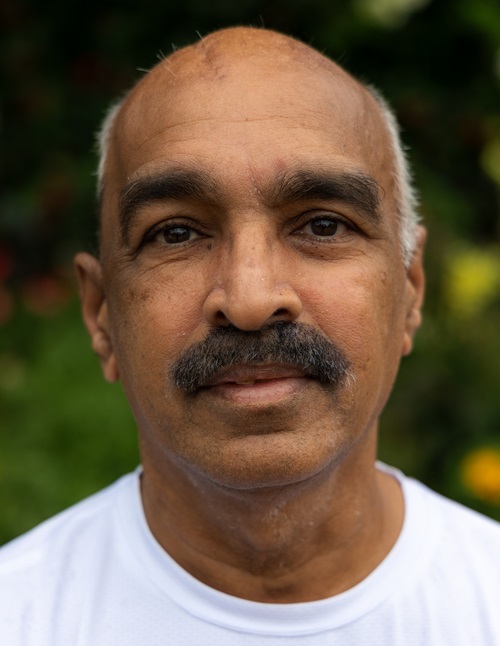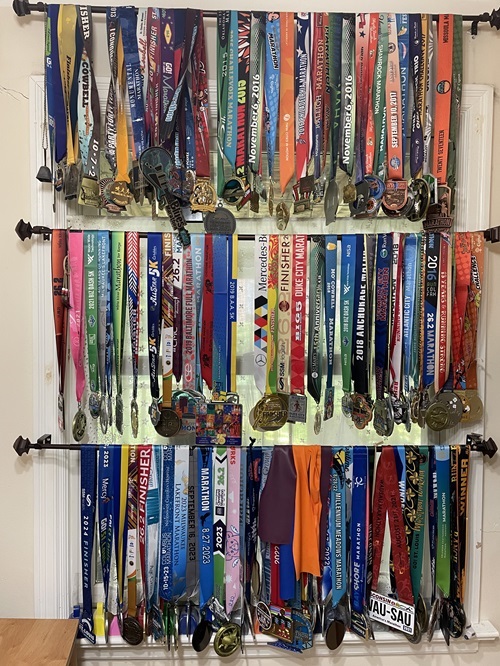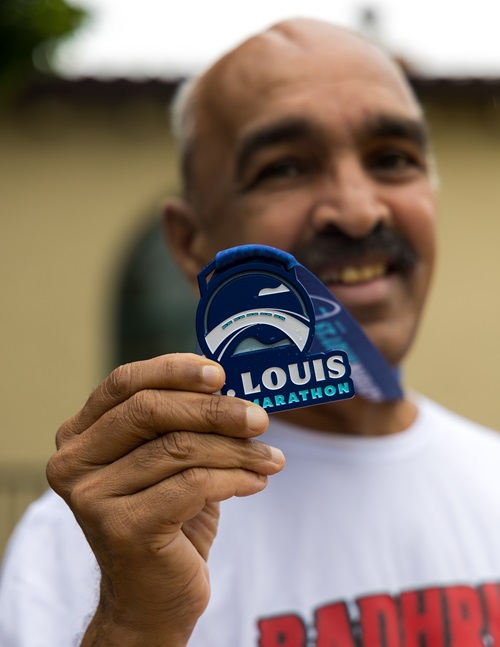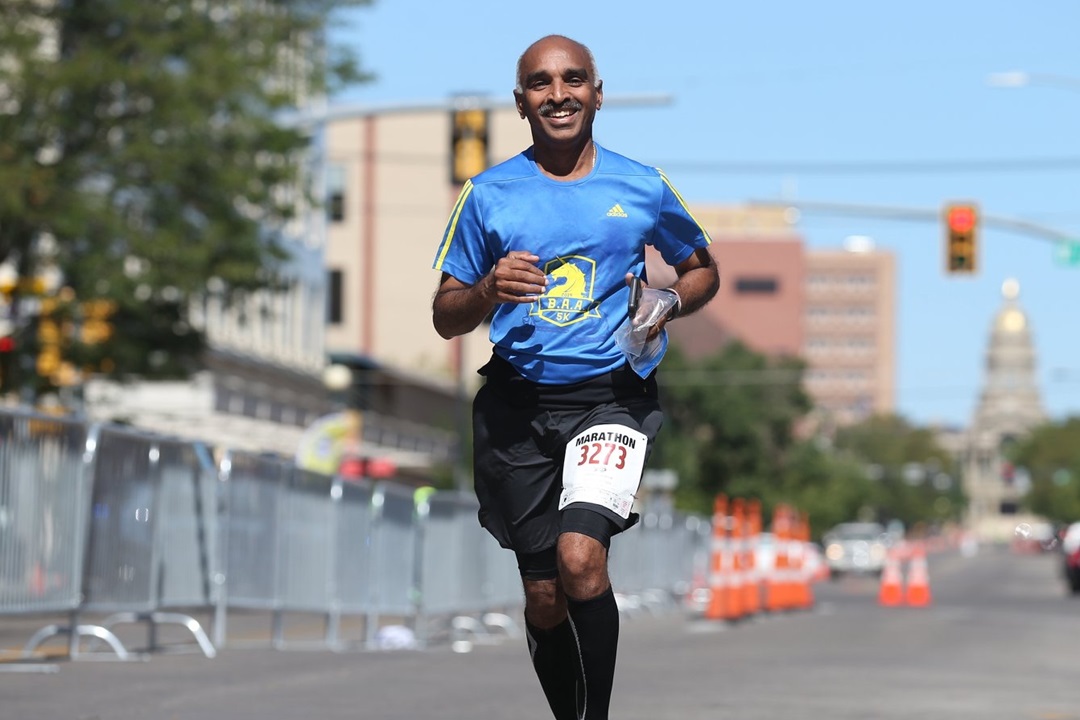On one hand, it was nothing new when Badhri Chakravarthy crossed the finish line of the Greater St. Louis Marathon in April of 2024. After all, he had run 99 previous marathons over the past 11 years, including at least one in all 50 U.S. states. On the other hand, this marathon was different: Chakravarthy, 64, completed it while battling brain cancer. Here, he discusses his passion for running, his cancer fight, and his advice for others.
BABY STEPS
“I’ve been a runner since 2013,” says Chakravarthy. “My son was running a half-marathon in Kansas City, so he put on Facebook, ‘Dad, it’s your turn.’ I started running as far as I could without joint pain: from my house to the end of the street. I did this five days per week. Then I said, OK, let me add some more distance. I got up to 1 mile. Then I said, can I do a 2-mile run? A 3-mile run? A 4-mile run? A 5-mile run? I could. Suddenly, I was talking to some running buddies at work. I signed up for five half-marathons in five consecutive weekends.”
HOOKED ON A FEELING
“Then I said, why don’t I try one full marathon? So I signed up for one in St. Louis, and I was able to do that. I thought, this is a trained body. Why don’t I try repeating one more marathon in four weeks? I didn’t know whether my body would be ready, but it was. Around the same time, my friends at work were talking about the 50-states marathon club: running a marathon in all 50 states. I got hooked to that concept. I started traveling, seeing new places, and making friends. I finished 50 marathons in 2019.”
PORTLANDIA
“My favorite marathon was in Portland, Oregon. It’s a completely flat course. There’s only one hill. You run over the bridge on mile 7 or so, and then you come down, and it’s flat again. So I got my best time up to that point, 3:46.”
MEET VIRGINIA
“My most difficult marathon was the Shamrock Marathon in Virginia Beach, Virginia. It was very cold that day, around 30 degrees, and it was snowing and raining. Icicles were falling and poking my eyes. On mile 24, we were running along the beach, and there was a sandstorm. Even the race people knew it was a very challenging marathon. Afterward, they served us vegetable soup and made us a T-shirt that said, ‘We Survived Shamrock.’”

In the face of a serious health condition, Badhri Chakravarthy demonstrated real grit. (Reiss Wegman)
WORK HARD, PLAN HARD
“Why do I run? It’s a lot of satisfaction and a lot of accomplishment. You feel that you trained hard, worked hard, planned hard. I should say: I’m a project manager by profession, so this gives me an extra kick because I apply all the project-management techniques. I do early registration because I want to spend minimal money. Then I book my flights early. I plan ahead of time so that when things fall into place, I get this feeling of satisfaction because everything worked out well.”
PREP SCHOOL
“I make a big spreadsheet of all my marathons. I track my time. I see whether I’ve done my hotel booking, my flight booking, my rental car. Everything is loaded in one spreadsheet. I keep looking at it all day long. That gives me a thrill and excitement, thinking that, hey, I got a few more things done here for my marathon.”
CANCER DIAGNOSIS
“In December of 2023, I ran a marathon in Memphis. A few days later, I came home from work. My head was very sweaty and kind of hurting. The left part of my body was not responding well. My wife decided to call 911, and I was taken to the hospital. Doctors found out I was bleeding inside the head. They had to do an emergency surgery to relieve the pressure and then two or three more surgeries for various things, including putting a shunt in my head to drain the liquid. I did rehab for a couple of days. Then I started on my chemo and radiation treatment.”
CENTURY CLUB
“I knew my hundredth marathon was coming up, and I wanted it to be in my hometown. I signed up for the St. Louis marathon one year back, but I didn’t sign up for my brain cancer at that point. As the days went by with my health setback, I wanted to somehow get ready for the hundredth marathon. So during all the treatment, I discovered I could do a lot of walking. I kept walking and walking. That was my nirvana. When I could do 20 miles of walking in a day, I realized that, yes, I’m ready for my marathon now. Even if it’s going to be completely walking.”

Over the last 11 years, Chakravarthy has racked up enough medals to fill a wall. (Courtesy of Badhri Chakravarthy)
SUPPORT SYSTEM
“But even in that marathon, I had plenty of support. At mile 15, I saw all my neighbors. I got so excited, and I told my two sons and my daughter-in-law, who were running with me, ‘Let’s run carefully.’ So from mile 15 to the finish line, we ran at a nice pace. It was very rewarding to run and finish with all the support from family and friends.”
PURSUING NORMALCY
“My son is a pharmacist. He handles a lot of cancer medication and cancer patients. He said that the intent of all this cancer medication is to put your life back to normalcy. I took those words literally, and I broke them apart. Before this cancer, I was able to walk, eat, sleep, go up the stairs, and come down. I was able to travel, socialize, have a drink here or there. I made a small list of 12 items, and I said, if I can do those 12 items, I am back to normal. So that was my driver, to come back to normal, doing all those things. These days, I’m feeling good because I’m pretty much doing everything.”
SECRETS TO SUCCESS
“I’m from south India. I eat a lot of rice. I eat a lot of lentils and other vegetables. So that’s my diet. I don’t need to intentionally carb load because I already do. I also make sure to avoid injury if I can. Having no injuries is very important because with so many marathons, your body has to recover and be ready for another marathon. So there’s no way you can afford to get injured. I don’t want to be a no-show in a marathon. I committed, so I have to run the marathon.”
WARDROBE MALFUNCTION
“At the marathon in Jackson, Mississippi, it was a cold race and they gave us a nice vest. It was so beautiful looking; it had a nice blue color. For the first time, I said, let me wear it in the marathon. At the end of the race, I came back to the hotel and had a shower. My neck was completely burning! Then I realized so much chafing happened with the brand-new clothing. So that was my big lesson learned: Never wear new clothing in a marathon. Use the same clothing that has been tried out and washed many times before.”

The medal for Chakravarthy’s 100th marathon was undoubtedly his most difficult to earn. (Reiss Wegman)
FOOT FAULT
“Also, your shoes are very important. Make sure that you are using a shoe that is half a size more than your regular shoe. I wear a size 10. So my running shoes are 10.5. If it’s a little loose, there is room for the foot to move and breathe. Otherwise, if it’s too tight, it may result in black toes.”
TRAIN YOUR BRAIN
“Mind control is very important to run a marathon. You got to commit. Commit means you register, first of all. Then you train toward completing it. How are you going to train? Gather some tips, whether it’s from Google or friends or whatever it is. Train to the fullest and make it happen. When you are at the finish line, you can see all the glory unfolds. You have completed what you committed to. That’s a nice feeling.”
WISE WORDS
“My advice for first-time marathon runners? Don’t worry about the clock. Don’t force yourself to run a certain time. Listen to the body and make sure there is no injury. That way, the next morning, you want to come back with full excitement, not with all the bodily pains. Even if it takes five more minutes of slow running to finish the marathon, it’s OK. It’s not the end of the world.”
Author: Shawn Donnelly is the managing editor of Terrain.
Top photo: Chakravarthy runs in a marathon in Cheyenne, Wyoming. (Courtesy of Badhri Chakravarthy)


Leave A Comment